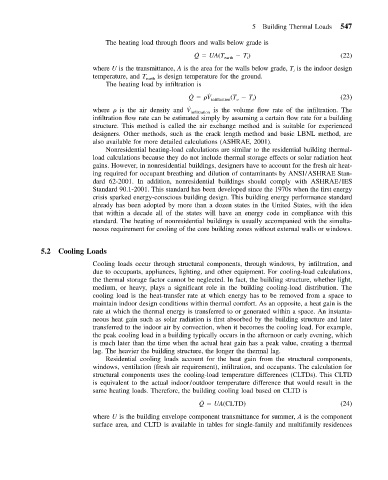Page 558 - Mechanical Engineers' Handbook (Volume 4)
P. 558
5 Building Thermal Loads 547
The heating load through floors and walls below grade is
˙
Q UA(T earth T ) (22)
i
where U is the transmittance, A is the area for the walls below grade, T i is the indoor design
temperature, and T earth is design temperature for the ground.
The heating load by infiltration is
˙
Q V ˙ infiltration (T T ) (23)
i
o
where is the air density and V ˙ infiltration is the volume flow rate of the infiltration. The
infiltration flow rate can be estimated simply by assuming a certain flow rate for a building
structure. This method is called the air exchange method and is suitable for experienced
designers. Other methods, such as the crack length method and basic LBNL method, are
also available for more detailed calculations (ASHRAE, 2001).
Nonresidential heating-load calculations are similar to the residential building thermal-
load calculations because they do not include thermal storage effects or solar radiation heat
gains. However, in nonresidential buildings, designers have to account for the fresh air heat-
ing required for occupant breathing and dilution of contaminants by ANSI/ASHRAE Stan-
dard 62-2001. In addition, nonresidential buildings should comply with ASHRAE/IES
Standard 90.1-2001. This standard has been developed since the 1970s when the first energy
crisis sparked energy-conscious building design. This building energy performance standard
already has been adopted by more than a dozen states in the United States, with the idea
that within a decade all of the states will have an energy code in compliance with this
standard. The heating of nonresidential buildings is usually accompanied with the simulta-
neous requirement for cooling of the core building zones without external walls or windows.
5.2 Cooling Loads
Cooling loads occur through structural components, through windows, by infiltration, and
due to occupants, appliances, lighting, and other equipment. For cooling-load calculations,
the thermal storage factor cannot be neglected. In fact, the building structure, whether light,
medium, or heavy, plays a significant role in the building cooling-load distribution. The
cooling load is the heat-transfer rate at which energy has to be removed from a space to
maintain indoor design conditions within thermal comfort. As an opposite, a heat gain is the
rate at which the thermal energy is transferred to or generated within a space. An instanta-
neous heat gain such as solar radiation is first absorbed by the building structure and later
transferred to the indoor air by convection, when it becomes the cooling load. For example,
the peak cooling load in a building typically occurs in the afternoon or early evening, which
is much later than the time when the actual heat gain has a peak value, creating a thermal
lag. The heavier the building structure, the longer the thermal lag.
Residential cooling loads account for the heat gain from the structural components,
windows, ventilation (fresh air requirement), infiltration, and occupants. The calculation for
structural components uses the cooling-load temperature differences (CLTDs). This CLTD
is equivalent to the actual indoor/outdoor temperature difference that would result in the
same heating loads. Therefore, the building cooling load based on CLTD is
˙
Q UA(CLTD) (24)
where U is the building envelope component transmittance for summer, A is the component
surface area, and CLTD is available in tables for single-family and multifamily residences

